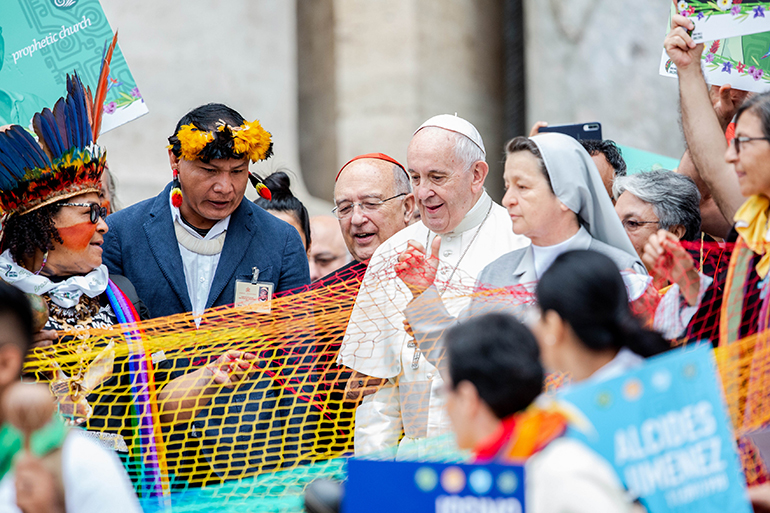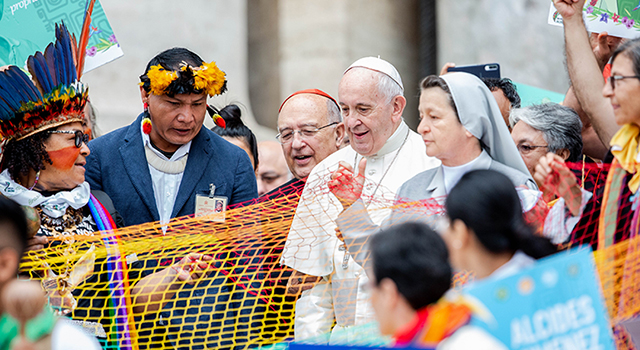By Rocio Granados - La Voz Catolica

Photographer: Catholic News Agency
Pope Francis leads the procession marking the opening of the Synod for the Amazon, from the Basilica of St. Peter to the synod hall, Oct. 7, 2019.
MIAMI | For the first time in history, the Church has dedicated a synod to the Amazon. Its objective is to identify new ways forward for evangelization and for combating climate change.
“Amazonia: New Paths for the Church and for an Integral Ecology” is the name of the Instrumentum laboris, the working document, with which representatives of nine countries whose territories cover portions of the Amazon will work for three weeks, from October 6-27.
“This is a Synod on the environment,” said Father Alfred Cioffi, an archdiocesan priest and director of the master’s program in bioethics at St. Thomas University in Miami Gardens. It is consistent with Pope Francis’ concern for the environment as a result of the ecological crisis of today. It also follows up on his 2015 encyclical, Laudato Si, the first in 2000 years of Church history to be dedicated to the environment and to the poor, who are the most affected by climate change.
The pope convened the synod at the request of several Catholic conferences of bishops from Latin America and of faithful from around the world.
The synod takes place on two levels, explained Father Cioffi. First, the environment. The vast fires a few months ago, not only in Brazil, but also in several countries that are part of the Amazon basin, affect the entire planet.
The Amazon is one of the two lungs of the world. The other is in the Congo, in Equatorial Africa. These forests are important because they trap and transform trillions of tons of carbon dioxide into oxygen, vegetation, and photosynthesis every day.
“It is very important to pay attention to the Amazon at this time,” said Father Cioffi. “Apart from being in the tropics, it has the largest amount of biodiversity in the world, many species of plants and animals.”
The second level is social: the indigenous tribes found in the Amazon. In January 2018, during his first visit to Amazonian territory, in Peru, the pope said, “The native Amazonian peoples have probably never been so threatened on their own lands as they are at present. Amazonia is being disputed on various fronts.”
There are about three million indigenous people in the Amazon, representing more than 390 ethnic groups that have a vital relationship with the vegetation and the rivers, according to data from specialized Church institutions, compiled in the Preparatory Document for the Synod for the Amazon.
To protect the rights of these peoples is of great importance to Pope Francis. During his speech in Peru to officially open the preparation for the synod, he said that there are major economic interests in oil, gas, timber, gold and agro-industrial monocultures in the Amazon. Indigenous territories are threatened by policies that promote the “conservation” of nature without taking into account the human being. This is causing natural resources to be inaccessible and the migration of new generations.
At the same time, according to preparatory documents for the Synod, in recent decades the Church in the Amazon has recognized that its pastoral presence is precarious because of the vastness of the territory, the great diversity of its peoples, and the rapid changes in socio-economic scenarios. Studying the possibility of ordaining older and married men as priests, preferably indigenous men who are respected and accepted by their community in remote regions of the Amazon, has been suggested.
Culturally, childlessness goes against nature for the indigenous, because family is fundamental for them. “This is a prerogative of the pope, who can announce it, and it would be just for them (the indigenous) for now,” said Father Cioffi.
In the history of the Church, celibacy was not a universal discipline for more than 1000 years. There were two traditions: that of celibates like John the Apostle, and those who were married, like Peter, the first pope. This can be found in the Gospel.
The Church self-imposed celibacy in the Lateran Councils of 1131 and 1139, and the practice was defended in the Council of Trent (between 1545 and 1563).
Celibacy exists for priests and bishops but permanent deacons can and are married. However, it is a discipline; it is not a doctrine. Doctrine is the Trinity, three divine persons, which cannot be questioned. But a discipline can be, by the authority of the pope.
The pope has removed the discipline of celibacy for married Anglican priests who have converted to Catholicism because the point is not to repudiate the wife or family.
Besides, the Eastern Catholic Churches, such as the Byzantines, have always had the tradition of both married and celibate clergy.
“The pope giving a dispensation to these individuals (married indigenous men of good reputation) is not new in the history of the Church. It is a very prudent and pastoral decision, specific to a group, which can be done to benefit the Gospel,” said Father Cioffi. E noted that this would not mean that the Church is opening the doors to accepting married priests in general.
“In my opinion that is still far away; celibacy remains the norm,” he said, adding that in the Archdiocese of Miami there are several priests who are married. They are older and prudent men who were Anglicans and converted to Catholicism.
FACTS ABOUT THE SYNOD FOR THE AMAZON
- Pope Francis convened it Oct. 15, 2017, to identify new paths for evangelization in the region. Particular attention, he added, will be paid to the indigenous people, “often forgotten and without the prospect of a serene future,” and to the crisis of the Amazonian rain forest, considered one of the world’s “lungs” because of the amount of oxygen produced by its abundant vegetation.
- Instrumentum laboris, the synod document, is divided into three parts: The Voice of the Amazon; Integral Ecology: The Cry of the Earth and of the Poor; and A Prophetic Church in the Amazon: Challenges and Hopes.
- A synod is a meeting of priests and bishops to discuss matters that affect the Church. It deals with a specific, current issue of which the pope needs comprehensive advice. There have been synods on the laity, family, youth, clergy, and this one on the environment.
THE AMAZON REGION
- It has 7.8 million square kilometers, almost the same size as Australia.
- It includes parts of Brazil, Bolivia, Peru, Ecuador, Colombia, Venezuela, Guyana, Suriname, and French Guiana. Brazil is the largest Catholic country in the world, in numbers of baptized Catholics.
- The Amazon River basin and the surrounding tropical forests nourish the soils and, through the recycling of moisture, regulate the water, energy and carbon cycles of the planet.


Comments from readers